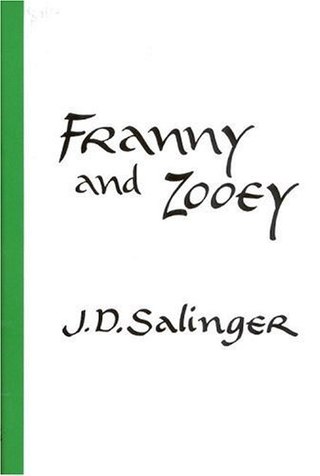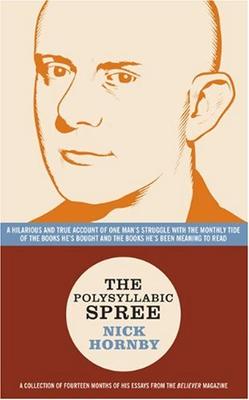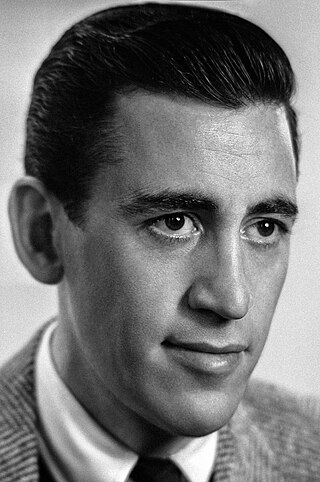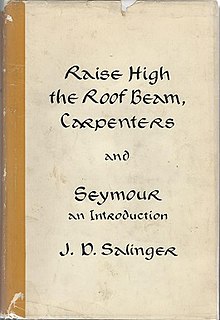“Hapworth 16, 1924” is an uncollected work of short fiction by J. D. Salinger which appeared in the 19 June 1965 issue of The New Yorker.

Holden Caulfield is a fictional character in the works of author J. D. Salinger. He is most famous for his appearance as the lead character and narrator of the 1951 novel The Catcher in the Rye. Since the book's publication, Holden has become an icon for teenage rebellion and angst, and is considered among the most important characters of 20th-century American literature. The name Holden Caulfield was initially used in an unpublished short story written in 1941 and first appeared in print in 1945.
"A Perfect Day for Bananafish" is a short story by J. D. Salinger, originally published in the January 31, 1948, issue of The New Yorker. It was anthologized in 1949's 55 Short Stories from the New Yorker, as well as in Salinger's 1953 collection Nine Stories. The story is an enigmatic examination of a young married couple, Muriel and Seymour Glass, on vacation in Florida. It is the first of his stories to feature a member of the fictional Glass family.

Franny and Zooey is a book by American author J. D. Salinger which comprises his short story "Franny" and novella Zooey. The two works were published together as a book in 1961, having originally appeared in The New Yorker in 1955 and 1957 respectively. The book focuses on siblings Franny and Zooey, the two youngest members of the Glass family, which was a frequent focus of Salinger's writings.
Pronoia describes a state of mind that is the opposite of paranoia. Whereas a person suffering from paranoia feels that persons or entities are conspiring against them, a person experiencing pronoia believes that the world around them conspires to do them good. The belief can be an irrational belief subject to medical diagnosis, or an enthusiastic, spiritual belief. The word entered the scientific literature in 1982 and was popularized by the Zippy movement in the 1990s.
The Glass family is a fictional family appearing in several of J. D. Salinger's short fictions. All but one of the Glass family stories were first published in The New Yorker. They appear in the short story collections Nine Stories, Raise High the Roof Beam, Carpenters and Seymour: An Introduction and Franny and Zooey.

"For Esmé—with Love and Squalor" is a short story by J. D. Salinger. It recounts a sergeant's meeting with a young girl before being sent into combat in World War II. Originally published in The New Yorker on April 8, 1950, it was anthologized in Salinger's Nine Stories two years later.

The Polysyllabic Spree is a 2004 collection of Nick Hornby's "Stuff I've Been Reading" columns in The Believer. The book collates his columns from September 2003 to November 2004, inclusive. It also includes excerpts from such authors as Anton Chekhov and Charles Dickens.

Dick Manning was a Russian-born American songwriter, best known for his many collaborations with Al Hoffman. Manning composed the first full-length musical to be broadcast on television. The Boys From Boise aired on the DuMont Television Network in 1944.
"The Laughing Man" is a short story by J. D. Salinger, published originally in The New Yorker on March 19, 1949; and also in Salinger's short story collection Nine Stories. It largely takes the structure of a story within a story and is thematically occupied with the relationship between narrative and narrator, and the end of youth. The story is inspired by the 1869 Victor Hugo novel of the same name: The Man Who Laughs.
"Uncle Wiggily in Connecticut" is a short story by J. D. Salinger, which appears in his collection Nine Stories. It was originally published in the March 20, 1948 issue of The New Yorker.
"Down at the Dinghy" is a short story by J. D. Salinger, originally published in Harper's in April 1949, and included in the compilation, Nine Stories.
This is a list of bestselling novels in the United States in the 1960s, as determined by Publishers Weekly. The list features the most popular novels of each year from 1960 through 1969.
"Teddy" is a short story by J. D. Salinger, completed on November 22, 1952, and originally published in the January 31, 1953, issue of The New Yorker. Under the influence of The Gospel of Sri Ramakrishna, Salinger created an engaging child character, Teddy McArdle, to introduce to his readership some of the basic concepts of Zen enlightenment and Vedanta reincarnation – a task that Salinger recognized would require overcoming some 1950s American cultural chauvinism.

Sevin Okyay is a Turkish literary critic, journalist, author, regular columnist and a prolific translator. Sevin had been a radio host and a teacher as well.
“The Heart of a Broken Story” is a work of short fiction by J. D. Salinger published in the September 1941 issue of Esquire.

Raise High is Radio America's second full-length album. The title of the record is said to have been taken from the J.D. Salinger novel Raise High the Roof Beam, Carpenters and Seymour: An Introduction.

Jerome David Salinger was an American author best known for his 1951 novel The Catcher in the Rye. Salinger published several short stories in Story magazine in 1940, before serving in World War II. In 1948, his critically acclaimed story "A Perfect Day for Bananafish" appeared in The New Yorker, which published much of his later work.

Neither Salinger in his lifetime nor his estate after his death has ever authorized publication of a volume of Salinger's registered early short fiction which appeared in magazines between 1940 and 1965. Reprints of his early stories have appeared under the auspices of Esquire and The New Yorker, to which Salinger stories had originally been sold.









